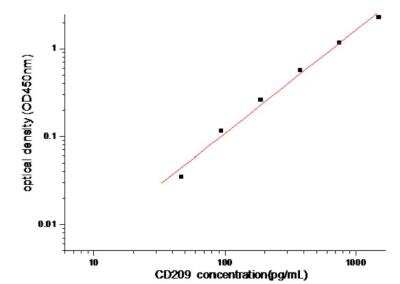DC-SIGN/CD209 Antibody Pair [HRP]
Novus Biologicals, part of Bio-Techne | Catalog # NBP2-79510

Key Product Details
Assay Type
Sandwich ELISA
Assay Range
23.44-1500 pg/ml (example only; lot dependent)
Sensitivity
23.4375 pg/ml (example only; lot dependent)
Reactivity
Human
Product Specifications
Description
Solid Phase sandwich ELISA for the quantitative determination of Human DC-SIGN/CD209.
Sample Volume Required
100 ul
Conjugate
HRP
Scientific Data Images for DC-SIGN/CD209 Antibody Pair [HRP]
Sandwich ELISA: DC-SIGN/CD209 Antibody Pair [HRP] [NBP2-79510] - This standard curve is only for demonstration purposes. A standard curve should be generated for each assay.
Kit Contents for DC-SIGN/CD209 Antibody Pair [HRP]
- Mouse Monoclonal Capture Antibody
- Rabbit Monoclonal Detection Antibody (HRP-conjugated): (Catalog # NBP2-89331)
- Standard
Preparation and Storage
Shipping
The product is shipped with polar packs. Upon receipt, store it immediately at the temperature recommended below.
Stability & Storage
Storage of components varies. See protocol for specific instructions.
Background: DC-SIGN/CD209
Long Name
Dendritic Cell-specific ICAM-3-grabbing Non-integrin 1
Alternate Names
CD209, CLEC4L, DC-SIGN1, DCSIGN
Gene Symbol
CD209
Additional DC-SIGN/CD209 Products
Product Documents for DC-SIGN/CD209 Antibody Pair [HRP]
Product Specific Notices for DC-SIGN/CD209 Antibody Pair [HRP]
This product is for research use only and is not approved for use in humans or in clinical diagnosis. Antibody Pairs are guaranteed for 6 months from date of receipt.
